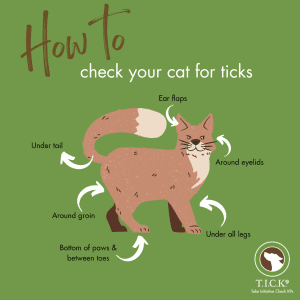

Tick-borne illnesses are infections spread from tick to host. Humans and dogs are often the most talked about when brainstorming prevention methods, but cats can also be bitten by ticks. Don’t fear, ohDEER is here to answer some of the most commonly asked questions about tick-borne illnesses in cats.
What ticks can spread infections to cats?
The types of ticks that can infect cats with diseases include the Brown dog tick, Black-legged (deer) tick, American dog tick and the Lone Star tick.
What tick-borne illnesses can cats get?
The six most common types of tick-borne diseases in cats include Lyme disease, Hepatozoonosis, Tularemia, Babesiosis, Cytauxzoonosis, and Anaplasmosis.
What are the symptoms of tick-borne illnesses in cats?
How to check a cat for ticks
It is important to check your cat for ticks to avoid them getting sick, or the tick jumping off and attaching to a person, spreading the same illnesses. Cats are meticulous groomers and sometimes remove ticks while cleaning themselves, but it is still important to brush your cat and help check them for ticks in the proper areas. Ticks are most likely to be found on the warmest parts of your cat’s body, due to their love for warm temperatures. This includes around the ear flaps, eyelids, legs and groin area as well as under the legs, tail, paws and between toes. This diagram should give you a better understanding of which spots to look for ticks.

How to remove a tick from a cat
How to prevent your cat from getting a tick bite
In better news, there are ways you can prevent your cat from being bitten by a tick. For starters, you can get flea and tick prevention. You can also get your backyard sprayed with All-Natural Tick & Mosquito Control from ohDEER. Consistently do tick checks on your cat after they go outside, a family member has been spending time outdoors, or if you have a dog.
Sources: